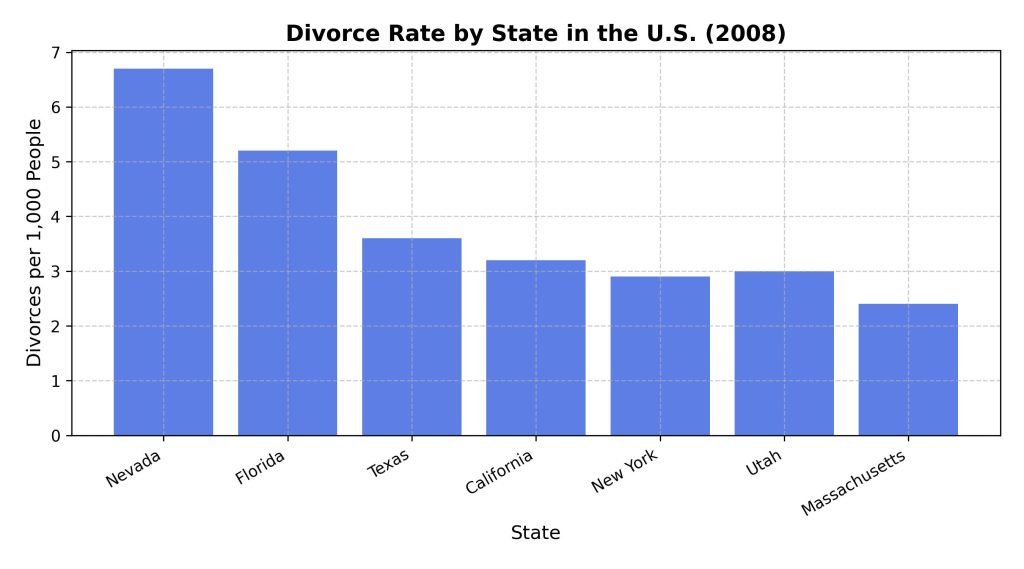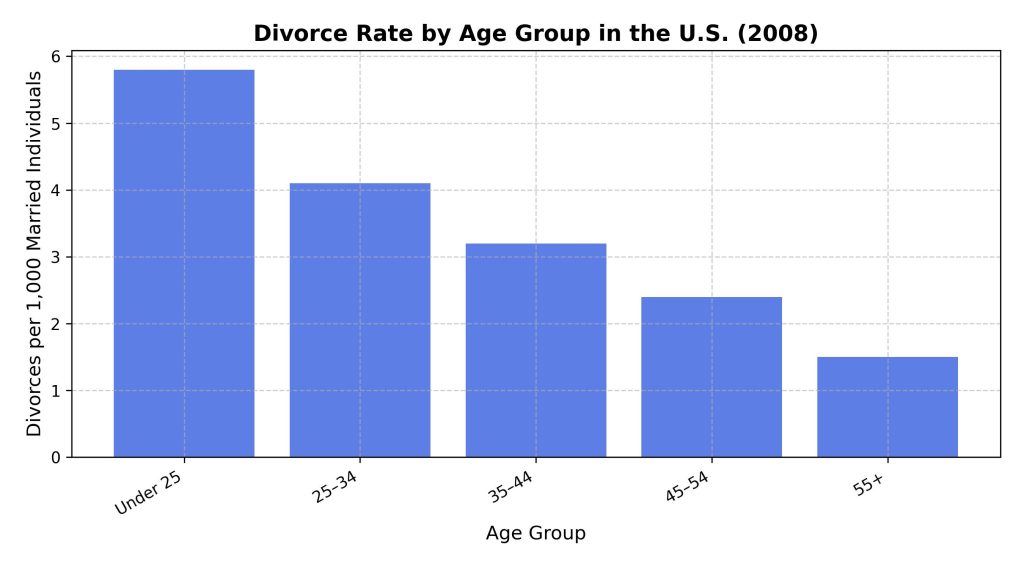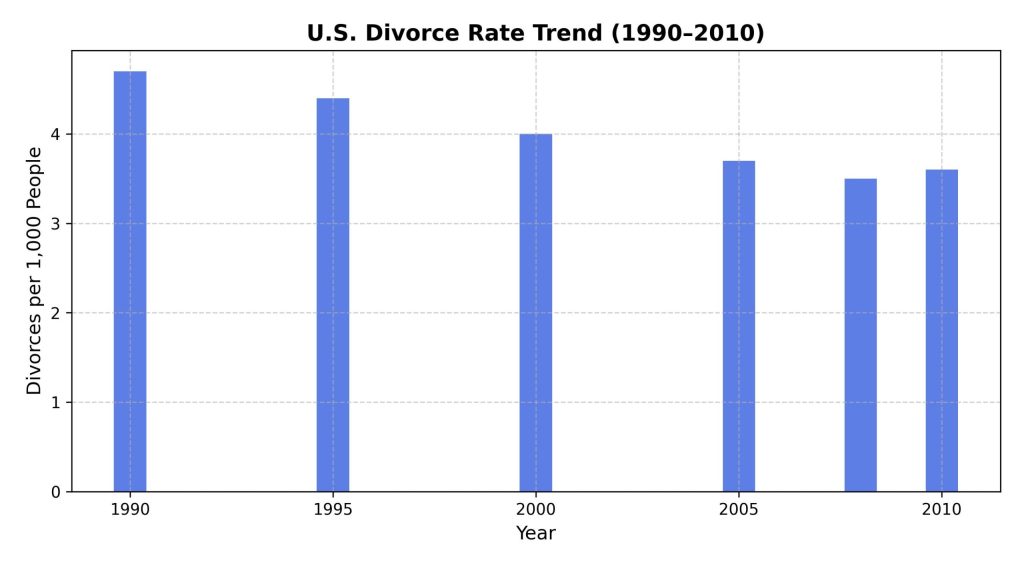Divorce Rate in the U.S., 2008: Trends, Ideas & Statistics
In 2008, the divorce rate in the U.S. was about 3.5 divorces per 1,000 people. According to the National Vital Statistics Reports by the Centers for Disease Control and Prevention, this rate showed a general drop from earlier decades. And something else that’s actually kind of cool, things affecting divorce included money problems and changes in cultural views on marriage. Many programs focused on counseling and teaching to help lower these rates.
When it comes down to it, marriage is often seen as key to happiness and a stable society. People usually talk about its good sides, but not so much about the problems, and that sorta explains it one big issue is the rising number of divorces, showing a different picture of societal norms. Some people view divorce as a fresh start or a path to freedom. Others might feel stuck between what society expects and what makes them happy, which seems connected to there are also those who see divorce as a step toward growth or family health. Too much focus on freedom or the self can backfire. In 2008, divorce rates were worth noting in the U.S. Hi, I’m Elizabeth Burnley, a paralegal, and today we’ll look at why divorce rates are important and how they might affect you.
Key Pointers
- In 2008, the divorce rate in the U.S. was about 3.5 out of every 1,000 people, showing a general decrease since the 1980s.
- The National Vital Statistics Reports by the Centers for Disease Control and Prevention point out that different social and money-related factors affected these trends.
- The recession and changing views on marriage were important reasons for the decline in divorce rates.
- Marriage rates stayed mostly the same during this time.
- More people became aware of living together as a real choice instead of getting married.

What were the main trends in the divorce rate in the U.S. in 2008?
In 2008, the divorce rate dipped slightly, proving that staying married through a recession is easier than splitting a credit card debt.
According to the U.S. census Bureau, the divorce rate in 2008 went down a little from previous years. The trend showed a leveling off in the number of divorces after decades of rising numbers. Reasons included money problems and changing public views on marriage.

Generally, on the internet, you can find various discussions about the trends in the divorce rate in the U.S. in 2008. On forums and blogs focused on social and economic trends, people often mention how the economic downturn impacted divorce rates during that time. Here are some direct quotes from different sources:
“As the financial crisis hit in 2008, many couples found themselves staying together out of economic necessity, which temporarily lowered the divorce rate.” – Blog post on Psychology Today
“Data from 2008 showed a modest decline in divorces, likely due to couples delaying separation because of the recession’s financial strain.” – User comment on a discussion thread on Reddit
“The economic pressures of 2008 didn’t just affect livelihoods, but also personal relationships, causing many to reconsider the cost of divorce.” – Article on The Atlantic

How did societal ideas and cultural perceptions in 2008 influence divorce rates?
In 2008, views on marriage began to change as more people saw divorce as an acceptable option, influenced by changing ideas on gender roles and personal happiness, which led some couples to end unhappy unions. I talked about how did societal ideas and cultural perceptions in 2008 influence divorce rates? a little at the start, but lets try to go a bit deeper this time. These new thoughts made it normal for individuals to view divorce as a real choice, giving them a chance to seek a better life without the old stigma of leaving a marriage, so I thought it was the right time to bring it in.
According to Britannica, social ideas and cultural views in 2008 affected divorce rates through changing social standards, money matters, and individual values. Main influences included divorce being seen as more usual, women becoming financially independent, and the importance of personal happiness over staying in an unhappy marriage. You won’t believe this, but, these changes led to new attitudes to marriage and separation, showing wider cultural changes.
What if this is only the start? I am seeing that people are talking about how ideas in 2008 are affecting divorce rates. They are saying that changing views on marriage and roles are making it easier for couples to part ways.

As divorce rates have seen shifts over the years, services like eDivorce Papers are becoming essential for going through this field efficiently. eDivorce Papers allows you to file for divorce online, making the process easy and quick. This website offers users affordable and simple solutions to manage their divorce paperwork without the stress of legal fees.
How about looking at how did societal ideas and cultural perceptions in 2008 influence divorce rates from a new angle? Sometimes it helps to think about it another way. Some people think the 2008 financial crisis led to more divorces right away, but it seems money issues made some couples put off splitting up because it was pricey. Instead of a quick split, couples might talk things out or try counseling to sort out their problems. It’s worth remembering that not every breakup has the same reason, and every couple’s story is different, no doubt.

What do the statistics from 2008 reveal about the demographic factors influencing divorce rates in the U.S.?
According to the National Center for Health Statistics, 2008 information points out main factors affecting U.S. And the part that I didn’t see coming is, divorce rates. These factors are age at marriage, with younger couples having higher divorce rates; education level, where people without a college degree had higher divorce rates; income level, with lower-income people having more divorces; and previous marital status, as those previously married had a higher chance of divorcing again. Understanding these factors can help in evaluating the risk and encouraging stability in marriages:
In 2008, divorce rates in the U.S. were affected by age, education, and income. Younger couples and those with less schooling had higher divorce rates. Experts suggest investing in education and helping couples’ programs to make relationships stronger.
My Concluding Remarks
In 2008, the divorce rate in the U.S. showed important trends and facts that highlighted both challenges and changes in the area of marriage. Despite these findings, there is hope for making relationships stronger through better talking, counseling, and community support. Couples can take practical steps by seeking expert advice and actively taking part in activities that build their bond to create lasting connections. For more insight into building strong partnerships, consider reading our article on effective talking tips for couples.







